by Patricia Herbig
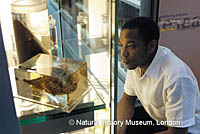 The Darwin Centre was built as an adjunct to the Natural History Museum to house and give access to the 22 million specimens collected and received by the NHM. Although it is part of the museum, the Darwin Centre’s main focus is research (when we were there last week, scientists were completing a 3 year study of the effects on marine life in the Gulf after the first Gulf War).
The Darwin Centre was built as an adjunct to the Natural History Museum to house and give access to the 22 million specimens collected and received by the NHM. Although it is part of the museum, the Darwin Centre’s main focus is research (when we were there last week, scientists were completing a 3 year study of the effects on marine life in the Gulf after the first Gulf War).
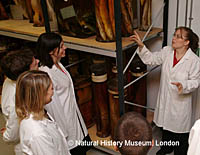 It is imperative to book a tour. It is possible to do this on-site and maybe get a tour later in the day, but this will be more difficult to do during public and school holidays. Tours last about 30 minutes and are guided by a member of the research staff. You will be asked to store in a locked locker any bags or lose articles of clothing and will be given a lab coat to wear. The guides are knowledgeable and willing to answer questions.
It is imperative to book a tour. It is possible to do this on-site and maybe get a tour later in the day, but this will be more difficult to do during public and school holidays. Tours last about 30 minutes and are guided by a member of the research staff. You will be asked to store in a locked locker any bags or lose articles of clothing and will be given a lab coat to wear. The guides are knowledgeable and willing to answer questions.
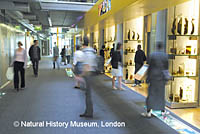 There are 27 kilometres of shelves ranged over 6 floors in the Darwin Centre as well as a large number of large metal storage containers in the basement. The specimens come from as long ago as the 1750s right up to today. All are stored in glass jars that need to be topped up regularly with alcohol to ensure their continued existence. You will not, of course, see them all; the guides pick an area and show some specimens from that section.
There are 27 kilometres of shelves ranged over 6 floors in the Darwin Centre as well as a large number of large metal storage containers in the basement. The specimens come from as long ago as the 1750s right up to today. All are stored in glass jars that need to be topped up regularly with alcohol to ensure their continued existence. You will not, of course, see them all; the guides pick an area and show some specimens from that section.
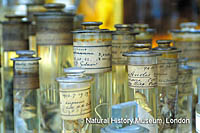 While children tend to be the ones we think of when we go to museums of this kind, I found it at least as interesting as my children did. The Darwin Centre has plans to extend the facilities by 2008 and add another building which will house their insects and larger mammals.
While children tend to be the ones we think of when we go to museums of this kind, I found it at least as interesting as my children did. The Darwin Centre has plans to extend the facilities by 2008 and add another building which will house their insects and larger mammals.
To book a tour, call: 020-7942-6128. Tours are given M-Sa, 10.00 – 17.30, Su 11.00 – 17.30 and are free. For additional information: www.nhm.ac.uk/darwincentre

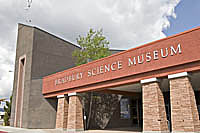 Whether you’re pro or anti, the history of the secret community of scientists who gathered in Los Alamos New Mexico during WWII to develop the first atomic bomb can’t help but fascinate. About 35 miles up the mountain from Santa Fe, the Los Alamos National Laboratory is still on the cutting edge of scientific research. The Lab isn’t generally open to the public, but the Bradbury Science Museum in the town of Los Alamos gives an overview of the Lab’s history and its current research.
Whether you’re pro or anti, the history of the secret community of scientists who gathered in Los Alamos New Mexico during WWII to develop the first atomic bomb can’t help but fascinate. About 35 miles up the mountain from Santa Fe, the Los Alamos National Laboratory is still on the cutting edge of scientific research. The Lab isn’t generally open to the public, but the Bradbury Science Museum in the town of Los Alamos gives an overview of the Lab’s history and its current research.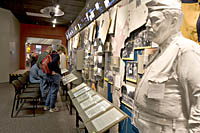 A short video gives the history of the creation of the National Science Laboratory during WWII and another on its current research. A History Gallery provides additional documents, photos, and videos on the Manhattan Project, the scientists involved and life in the secret scientific community that went nameless until after the war.
A short video gives the history of the creation of the National Science Laboratory during WWII and another on its current research. A History Gallery provides additional documents, photos, and videos on the Manhattan Project, the scientists involved and life in the secret scientific community that went nameless until after the war.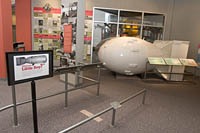 The Defense Gallery focuses on the National Security functions of the Lab and what it does to ensure the safety of existing “nuclear deterrents.” This exhibit has a “Fat Man” bomb casing identical to the one dropped on Nagasaki as well as various other missile casings. There is also an exhibit about where plutonium comes from, its risks and what measures are taken to dispose of it safely. There are a variety of interactive exhibits, including a biometric security turnstile, where you can scan an ID card (provided) and use your hand print to get through the security gate.
The Defense Gallery focuses on the National Security functions of the Lab and what it does to ensure the safety of existing “nuclear deterrents.” This exhibit has a “Fat Man” bomb casing identical to the one dropped on Nagasaki as well as various other missile casings. There is also an exhibit about where plutonium comes from, its risks and what measures are taken to dispose of it safely. There are a variety of interactive exhibits, including a biometric security turnstile, where you can scan an ID card (provided) and use your hand print to get through the security gate.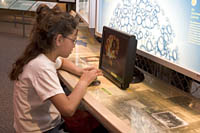 In the Research Gallery, you can learn about the human genome, space science research, radiation, lasers and other ongoing Laboratory research. The exhibits are designed for school-age children through adults. Admission is free. Many of the exhibits are interactive.
In the Research Gallery, you can learn about the human genome, space science research, radiation, lasers and other ongoing Laboratory research. The exhibits are designed for school-age children through adults. Admission is free. Many of the exhibits are interactive.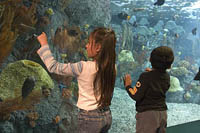 You can’t go wrong on a rainy day in Long Beach taking the kids out for a day at the Aquarium of the Pacific. A real deluge might keep the Lorikeet forest closed, but it won’t bother the sharks and rays in the outdoor touch pools. It will just scare away a bit of the competition for a good position to two-finger touch these creatures of the sea.
You can’t go wrong on a rainy day in Long Beach taking the kids out for a day at the Aquarium of the Pacific. A real deluge might keep the Lorikeet forest closed, but it won’t bother the sharks and rays in the outdoor touch pools. It will just scare away a bit of the competition for a good position to two-finger touch these creatures of the sea.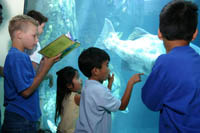 Most of the Pacific Ocean animals on display in the Aquarium can be viewed without your umbrella. The Weird, Wild and Wonderful Passport Book that you receive at the entrance helps identify the various underwater residents as you go. It includes a fun quiz at the back for school-age children or anyone who wants to test their memory. Weekdays the schools of fish are visited by schools of little people identified with matching bandanas, hats or T-shirts.
Most of the Pacific Ocean animals on display in the Aquarium can be viewed without your umbrella. The Weird, Wild and Wonderful Passport Book that you receive at the entrance helps identify the various underwater residents as you go. It includes a fun quiz at the back for school-age children or anyone who wants to test their memory. Weekdays the schools of fish are visited by schools of little people identified with matching bandanas, hats or T-shirts.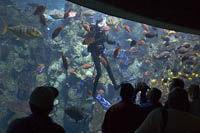 her calf suspended from the ceiling. The Aquarium is divided into geographic regions which reproduce the local habitat for the undersea inhabitants of that area. At the end of the hall, the Blue Cavern exhibit, extending two stories high, represents the habitat of the Southern California Coast and Islands. At feeding time, you can see exotic Homo sapiens in scuba gear swimming among the California barracudas, shovelnose guitarfish and leopard sharks. Volunteer divers give underwater presentations several times a day. The two-legged scuba-fish also make appearances in the Tropical Reef Exhibit.
her calf suspended from the ceiling. The Aquarium is divided into geographic regions which reproduce the local habitat for the undersea inhabitants of that area. At the end of the hall, the Blue Cavern exhibit, extending two stories high, represents the habitat of the Southern California Coast and Islands. At feeding time, you can see exotic Homo sapiens in scuba gear swimming among the California barracudas, shovelnose guitarfish and leopard sharks. Volunteer divers give underwater presentations several times a day. The two-legged scuba-fish also make appearances in the Tropical Reef Exhibit.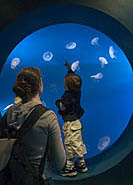 It is easy to become transfixed for long periods of times watching the translucent jellies floating through the blue water of the Open Ocean or waiting to see if the balloonfish are going to balloon in the Sea of Cortez. If it’s too wet to have the Seals and Sea Lion presentation outside, you can still view these sea mammals from inside the Southern California and Baja Gallery. You can also watch the sea otters cavort and play in and out of water in the Northern Pacific Gallery.
It is easy to become transfixed for long periods of times watching the translucent jellies floating through the blue water of the Open Ocean or waiting to see if the balloonfish are going to balloon in the Sea of Cortez. If it’s too wet to have the Seals and Sea Lion presentation outside, you can still view these sea mammals from inside the Southern California and Baja Gallery. You can also watch the sea otters cavort and play in and out of water in the Northern Pacific Gallery.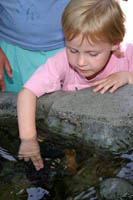 In the outdoor section of the Southern California and Baja Exhibit, you can give the two-finger touch to a giant green anemone, purple sea urchin or bat star in the sheltered Rocky Intertidal exhibit or to the nearby stingrays and whiptail rays competing for your attention in the Ray Touchpool. Downstairs you can pet the white-spotted bamboo sharks, zebra sharks and many other small shark varieties in the Shark Lagoon.
In the outdoor section of the Southern California and Baja Exhibit, you can give the two-finger touch to a giant green anemone, purple sea urchin or bat star in the sheltered Rocky Intertidal exhibit or to the nearby stingrays and whiptail rays competing for your attention in the Ray Touchpool. Downstairs you can pet the white-spotted bamboo sharks, zebra sharks and many other small shark varieties in the Shark Lagoon.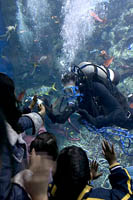 Films and presentations are scheduled throughout the day in the Honda Theater near the entrance and in the outdoor Marine Life Theater, weather permitting. Guided hour-long “Behind the Scenes” Tours for visitors seven years old or above are available daily for an additional fee. On weekends, you can make a reservation for Animal Encounters, which will allow you to get up close and personal while you feed the animals with the Aquarium staff. Children have to be at least ten years old to feed the seals and sea lions and 13 to feed the sharks.
Films and presentations are scheduled throughout the day in the Honda Theater near the entrance and in the outdoor Marine Life Theater, weather permitting. Guided hour-long “Behind the Scenes” Tours for visitors seven years old or above are available daily for an additional fee. On weekends, you can make a reservation for Animal Encounters, which will allow you to get up close and personal while you feed the animals with the Aquarium staff. Children have to be at least ten years old to feed the seals and sea lions and 13 to feed the sharks.